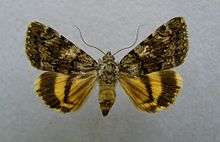Catocala nymphagoga
Catocala nymphagoga, the oak yellow underwing, is a moth of the family Erebidae. It is found in Southern Europe, from Bulgaria up to the Iberian Peninsula and sometimes further north as a migrant. It is also found in North Africa and Asia Minor.
| Catocala nymphagoga | |
|---|---|
 | |
| Scientific classification | |
| Kingdom: | |
| Phylum: | |
| Class: | |
| Order: | |
| Family: | |
| Genus: | |
| Species: | C. nymphagoga |
| Binomial name | |
| Catocala nymphagoga | |
| Synonyms | |
| |
Technical description and variation
C. nymphagoga Esp. ( = uxor Hbn. part. Forewing grey more or less wholly suffused with blackish brown, the basal area, or at least its lower half, a costal patch beyond inner line, a streak from costa before outer line, and the submarginal line itself remaining pale; inner and outer lines velvety black, distinct, sometimes doubled; the inner oblique, dentate inwards on the veins; the outer biangulate externally (in vein 5, forming a deep sinus inwards, its end below the reniform pale, and an inward angle on vein 1: reniform indistinct, obscured by the brown median shade, with dark centre and outline; subterminal line waved, distinct, with darker dentate edges; hindwing yellow, with broad black terminal border, containing a small yellow spot at apex and a sinus inwardly in submedian interval: the median band narrow and straight, acutely or squarely angled on the submedian fold, the base of wing often darkened with olive fuscous; - the darkest specimens, with the forewings almost unicolorous black brown, form the ab. anthracita Th.-Mg. : tmolia Led. has the forewing pale grey; the black median band of hindwing not angled but obscure, acutely zigzag between the veins, which are black; reniform stigma followed by a dark grey cloud, and containing a pale yellowish lunule at centre: hindwing dull red, with a narrow nearly straight black median band, shortly angled inwards on submedian fold; terminal border black, broad at apex, evenly curved on inner edge, and with a deep sinus on submedian interval.; Specimens from Uralsk are all smaller, uniform brownish grey, without any black and white shading; the lines line and slight; the black streak from base above and below the submedian fold well marked; hindwing with medianband curved, thinner; terminal border nearly or quite interrupted across submedian interval. They may be distinguished for the present as subsp. detrita subsp. nov.[now full species Catocala detritaWarren, 1913'. Larva extremely like that of electa, pale yellowish grey, finely black-dotted, with two obscure dorsal streaks; hump on segment 9 small, yellowish; that on 12 slight and bifid; head small, grey with dark marks and two small reddish protuberances. [2]The wingspan is 35–43 millimetres (1.4–1.7 in).
Biology
Adults are on wing from June to August depending on the location.
The larvae feed on Quercus species.
References
- Yu, Dicky Sick Ki. "Catocala nymphagoga (Esper 1787)". Home of Ichneumonoidea. Taxapad. Archived from the original on March 15, 2016.
- Warren. W. in Seitz, A. Ed., 1914 Die Großschmetterlinge der Erde, Verlag Alfred Kernen, Stuttgart Band 3: Abt. 1, Die Großschmetterlinge des palaearktischen Faunengebietes, Die palaearktischen eulenartigen Nachtfalter, 1914

External links
| Wikimedia Commons has media related to Catocala nymphagoga. |
- Oak yellow underwing on UK Moths
- Fauna Europaea
- Lepiforum.de
- Lepidoptera of Belgium
- New moth species in Belgium (in Dutch), De Standaard Online, 27 July 2009